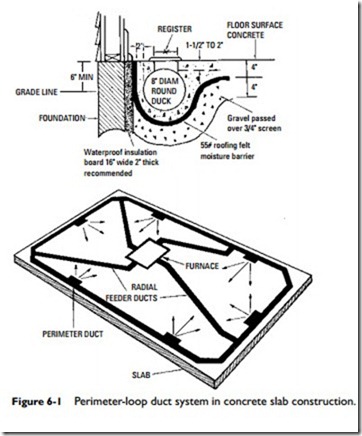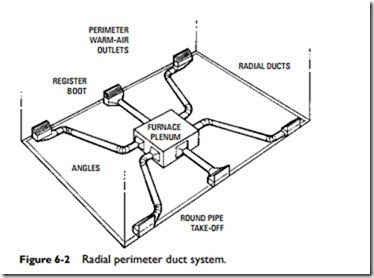Warm-Air Heating Systems
Air is the medium used for conveying heat to the various rooms and spaces within a structure heated by a warm-air furnace. It is also the principal criterion for distinguishing warm-air heating systems from other types in use.
The warm-air furnace is a self-contained and self-enclosed heating unit that is usually (but not always) centrally located in the structure. Depending upon the design, any one of several fuels can be used to fire the furnace. Cool air enters the furnace and is heated as it comes in contact with the hot metal heating surfaces. As the air becomes warmer, it also becomes lighter, which causes it to rise. The warmer, lighter air continues to rise until it is either discharged directly into a room (as in the so-called pipeless gravity system) or carried through a duct system to warm-air outlets located at some distance from the furnace. After the warm air surrenders its heat, it becomes cooler and heavier. Its increased weight causes it to fall back to the furnace, where it is reheated and repeats the cycle. This is a very simplified description of the operating principles involved in warm-air heating, and it especially typifies those involved in gravity heating systems.
Classifying Warm-Air Heating Systems
A warm-air heating system is one in which the air is heated in a furnace and circulated through the rest of the structure either by gravity or motor-driven centrifugal fans. If the former is the case, then the system is commonly referred to as a gravity warm-air heating system. Any system in which air circulation depends primarily on mechanical means for its motive force is called a forced-warm-air heating system. The stress on the word “primarily” is intentional because some gravity warm-air systems use fans to supplement gravity flow, and this may prove confusing at first. In any event, one of the oldest forms of classifying warm-air heating systems has been on the basis of which method of air circulation is used: gravity or forced air.
Forced-warm-air heating systems are often classified according to the duct arrangement used. The two basic types of duct arrangements used are:
1. Perimeter duct systems
2. Extended-plenum duct systems
A perimeter duct system is one in which the supply outlets are located around the perimeter (i.e., the outer edge) of the structure, close to the floor of the outside wall or on the floor itself. The return grilles are generally placed near the ceiling on the inside wall. The two basic perimeter duct systems are:
1. The perimeter-loop duct system (Figure 6-1)
2. The radial-type perimeter duct system (Figure 6-2)
An extended-plenum system (Figure 6-3) consists of a large rectangular duct that extends straight out from the furnace plenum in a
straight line down the center of the basement, attic, or ceiling. Round supply ducts connect the plenum to the heat-emitting units.
These and other modifications of duct arrangements are described in considerable detail in Chapter 7 of Volume 2, “Ducts and Duct Systems.”

